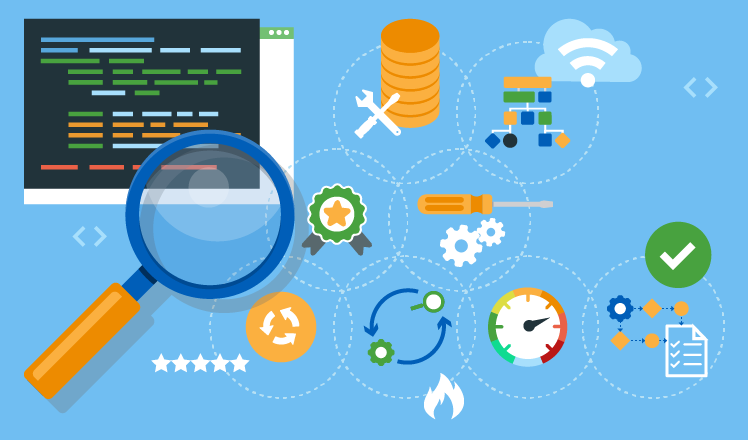Top Software Testing Trends to Watch For in 2025
Editor's note: In this article, Victor uncovers the latest buzz in the QA domain, from digital transformation to further cloud and IoT adoption. He also sheds light on the latest software testing trends, like AI-powered testing and performance engineering. With 36 years of experience, ScienceSoft is your go-to-source for insightful perspectives on how QA and testing are adapting to this ever-changing landscape.
Software development is changing due to the emergence of new technologies and methodologies of development process organization. And software testing transforms respectively, as it should match technological and methodological advances to ensure the high quality of software. If you want to keep up with the new testing approaches, carry on reading – in this article, we’ve highlighted IT trends that fuel changes in the QA domain and summarized the emerging software testing trends.

Modern challenges in software testing
The following tech trends will persist through 2025 inducing changes in test process organization, expanding the range of tested application types, creating demand for new QA engineers’ skills, and thus shaping up a new face of software testing.
Digital transformation
Businesses continue to undergo intense digital transformation and become more dependent on technology. This sets high requirements to the reliability and stability of software. Hence, the importance of digital quality assurance has been growing exponentially as well. This, in turn, leads to a surge in IT budgets dedicated to QA and testing. The share of IT budgets spent on these activities reached its peak (35%) in 2015 and is predicted to increase again in 2025. This year, about 51% of organizations are actively planning to boost their IT spending. At the same time, digital transformation presupposes experimenting with digital features, which calls for the agility and flexibility of the development and QA processes.
As a result, quality assurance faces contradicting demands for stability and flexibility, which sets a challenge for QA managers. They continue to search for new, non-trivial ways of setting QA processes in a way that enables meeting both requirements.
Transition to continuous integration, continuous delivery (CI/CD)
Organizations adopt DevOps practices and establish CI/CD pipelines, which presupposes delivering small chunks of software in fast and frequent iterations. This IT trend makes QA teams respond in two ways. First, test engineers face the need to adopt a shift-left approach and start testing activities as early in the software delivery cycle as possible. Second, test teams are required to build and maintain result-oriented collaboration with development teams, who are also involved in the QA process. The development teams create and run unit tests, while test teams validate software at the API and UI layers.
Further transition to the cloud and increasing adoption of IoT
With scalability in mind, an increasing number of businesses move data storage and processing to the cloud. Gartner predicts that cloud will become a business necessity by 2028. An average company uses 254 SaaS apps today. At the same time, there is an increase in the number of organizations adopting IoT, as this technology provides access to previously unavailable enterprise and customer data and allows organizations to make informed business decisions based on this data. IoT Analytics reports that 79% of businesses intend to invest significant amounts of money into at least one IoT project in 2025.
Quality assurance for cloud-based and IoT applications calls for much more specialized skills of QA engineers and requires QA teams to better understand these apps’ implications on organizations’ business processes.
Emerging software testing trends
Software testing trends can be grouped into two categories based on the aspect of the testing process they affect:
- Software testing trends regarding the approaches to testing.
- Software testing trends regarding the object of testing.
Trends in the approaches to testing
Increasing levels of test automation
With reasonable test automation, test teams can achieve required test coverage while meeting stringent iteration deadlines. Test automation requires consolidated effort from the development, testing and operations teams as it means automating not only functional test cases but also pre- and post-testing activities, for example, test environment setup and test data provisioning. It is important to note that an increased share of automation doesn’t eliminate manual testing. Such testing types as exploratory and usability testing continue to be performed manually.
Performance engineering
In 2025, performance engineering is expected to gradually replace performance testing techniques. The focus of performance engineering is on analyzing how to prevent and forecast software performance issues. A performance engineer should be involved from the initial software development stages to ensure that software’s design and architecture won’t cause performance defects in the future. Such a shift requires sufficient code, database schema, and queuing theory understanding from an engineer.
Leveraging Artificial Intelligence (AI) in testing
In software quality assurance, it may be possible to apply AI for:
- Log analytics, identifying unique test cases that have to be executed manually and not become automated.
- Test suite optimization, determining redundant test cases.
- Traceability, extracting keywords from the Requirements Traceability Matrix (RTM) to ensure sufficient requirements' coverage with test cases.
- Predictive analytics, forecasting key parameters and specifics of end users’ behavior and identifying application areas to prioritize based on the forecasts.
- Defect analytics, identifying those application areas, defects in which are bound to the highest business risk.
Although there’s enthusiasm for AI-driven testing and the potential of using AI in quality assurance is promising, it is still an emerging trend. The knowledge, skills and expertise required are still lacking in many organizations.
Trends regarding the object of testing
SaaS testing
Basic testing types (functional, performance, compatibility, security, and other types of testing) are executed with regard to the SaaS peculiarities, such as frequent software updates, multi-tenancy, and opportunities to tune a unified SaaS solution to multiple tenants’ specific business logic. For instance, during functional testing, a test engineer should not only verify the solution’s default functionally against the requirements specification but also test configuration use cases.
Testing of data-centric applications
Thorough data warehouse and business intelligence testing should ensure sleek functioning of data-centric applications and ETL (extract, transform, load) processes. Performing these types of testing requires QA engineers to acquire new knowledge, for instance, understanding of data warehousing concepts, architectures and processes, knowledge of SQL query scripts and ETL mapping documents.
IoT application testing
IoT testing is performed at multiple layers of an IoT architecture, such as a layer of smart things, a network layer, a cloud server layer, and a layer of user applications. In an average IoT testing process, the following types of testing are implemented:
- Functional testing is performed at the layers of smart devices, cloud server and user apps to validate that the components of an IoT solution function according to the requirements specification.
- Compatibility testing is performed at the network and user application layers to verify that IoT software functions according to the requirements on relevant endpoint devices and is compatible with different embedded software versions and communication protocols.
- Usability testing is performed for user applications and includes the verification of apps’ navigation, structure, workflows, and content accessibility.
- Security testing is performed at all layers of an IoT architecture to validate data privacy controls and user authentication processes.
- Interoperability testing is performed to validate that multiple components of an IoT architecture interoperate according to the requirements specification without data losses and reductions in an IoT solution’s performance.
- Performance testing involves checking an IoT solution’s reliability and response time under normal, extreme and continuous load.
- Compliance testing is executed for the whole IoT solution to verify that it complies with relevant industry-specific regulations, for instance, HIPAA, PCI DSS.
To sum it up
The emergence and further spread of new technologies and methodologies to software development set a range of requirements for software quality control. The testing process adapts to the new reality in two ways: there emerge new approaches to the software testing process organization and the objects of testing become more diverse. To stay up-to-date, QA professionals should be ready to learn new software testing technologies and acquire new skills and competencies.

